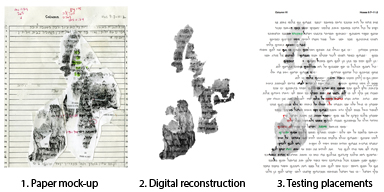
Applying Technology to Rebuild a Bible
Religious Studies Associate Professor Catherine (Kitty) Murphy and Religious Studies and Classics major Jonathan Homrighausen '15 are working together to reconstruct fragments of the Dead Sea Scrolls. While Murphy was a doctoral candidate at the University of Notre Dame, she assisted with the publication of the biblical scrolls and knew that one of them needed additional work. The particular scroll she and Homrighausen are now reconstructing—a two-thousand year old copy of the twelve minor prophets (see note below)—is in terrible shape, with some fragments still fused together in layers, many too dark to be read with the naked eye, and over 150 fragments with words on them that the original editor had not had time to decipher. Furthermore, Murphy has discovered old photographs revealing fragments that were not catalogued with the official publication. Even more amazing, and as yet widely unknown, Murphy discovered that the central core of the leather scroll still lies rolled on its winding stick in a box in the storage vault of the Israel Antiquities Authority. This scroll is on animal skin, and the collagen has deteriorated on these inner parts of the roll, leaving little cell structure behind and giving the scroll the consistency of glue.
While all of these obstacles have hindered research to date, Murphy regards them as opportunities. Layered fragments preserve evidence of the relative location of fragments in their original columns, thus allowing the scroll to be reconstructed. As reconstruction proceeds, it reveals the damage patterns and disintegration of the scroll that permit small unidentified fragments to be placed on the basis of their shapes and letter contents, much like a giant puzzle. Murphy first xeroxed all the photographs of the fragments and built a scroll mock-up on paper to keep track of her reconstructions and placements (frame 1 in the picture). With $3,000 in grants from the College of Arts and Sciences dean, she secured high-quality digital images of all of the scroll’s 300+ fragments, many of which reveal as yet unknown contents, and then began using Adobe Photoshop to create a virtual scroll. The image files had to be scaled to each other, then each of the hundreds of fragments isolated into separate files with background removed. This then allows Murphy to paste each fragment into its proper place in the virtual scroll (frame 2), and separate the layers of multilayered fragments so that they can be re-located into their original columns. She also created a font mimicking the scribe’s handwriting so that the entire expected contents of the 52 estimated columns of the manuscript could serve as a base for testing fragment placements (frame 3). She has traveled to conferences to share her work with $3,000 in support from the Religious Studies Department, and hopes to receive funding from the Dead Sea Scrolls Foundation to subsidize travel to Israel to examine the manuscript in person on a sabbatical next year.

For the past nine months, with the support of a $1,000 Faculty-Student Research Assistant Grant from the Provost’s Office, Jonathan Homrighausen has been able to apply his skills in Hebrew and Greek to the reconstruction effort. He is helping to typeset the reconstruction for publication, while reading through the twelve minor prophets in Hebrew with Murphy and analyzing variants. He writes:
"As an undergraduate, it’s easy to feel like I can’t put my knowledge to good use for the world. This project has helped me use the skills from my three years of Hebrew to good use. I enjoy that greatly. But don’t get me wrong: textual criticism is frustrating… there are fragments that remain unidentifiable, and we have found only minor spelling differences, not history-making variants. But most importantly, throughout our collaboration, Dr. Murphy has shown me a model of the kind of work that creates good scholarship: slow, careful, often unexciting but always thorough. I hope to carry this model into graduate school and my future life as an academic."
That academic collaboration extends beyond campus. Murphy has begun conversations with people in the field to prompt an international conservancy project to “read” the unrolled and gelatinous center of this scroll. Some promising X-ray techniques have been developed for a villa library in Herculaneum near Pompeii, whose scrolls were carbonized in the 79 CE eruption of Mount Vesuvius, eleven years after the Dead Sea Scrolls were hidden. Two thousand years later, advances in technology are permitting us to read these incredible discoveries which otherwise remained concealed, even after being found, and to bring the study of ancient and familiar texts into the twenty-first century.
Note: 4Q82, 4QXIIg. The Twelve Minor Prophets are so-called because their books are relatively short, and all twelve could be copied on one scroll. They include Hosea, Joel, Amos, Obadiah, Jonah, Micah, Nahum, Habakkuk, Zephaniah, Haggai, Zechariah and Malachi.
Related Links:
- Online collection funded by George Blumenthal and the Center for Online Judaic Studies.
- The Leon Levy Dead Sea Scrolls Digital Library